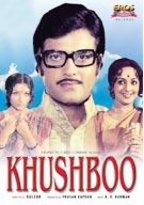Khushboo

http://www.rediff.com/movies/2003/apr/12dinesh.htm
Review by: Dinesh Raheja
She may have never heard of feminism, but there is something very appealing and affirmative about the female protagonist of Gulzar's Khushboo. A product of her times, this rural woman of substance and silences is also determinedly self-assertive.
Hema plays Kusum, whose life is an agony of self-repression slightly tempered by hope and anticipation. In her childhood, Kusum was engaged to marry close companion Brindaban (Jeetendra). An inter-family fallout prompts Brindaban's brusque father to humiliate her and her mother. We are given an insightful look into Kusum's personality when we see her next, burning the flesh of her own hand on which Brindaban's name is tattooed.
Kusum is not able to expunge from her heart and mind the belief that Brindaban is her husband. Brindaban, now a doctor and widower with a son (Master Raju), returns after years elapse, and Kusum has decidedly mixed feelings.When Brindaban's benign but innately patronising mother (Durga Khote) meets Kusum's brother Kunj (Asrani) and counsels against Kusum's unmarried state, Kusum snaps at him, "Kunwari kehte huey sharam nahin aayi unhe? Mere liye bheekh maangne ki koi zaroorat nahin [Wasn't she ashamed to call me unmarried? There's no need to beg for me]."
Later, Brindaban's mother offhandedly gifts her some bangles considered an auspicious token of a forthcoming marriage. Kusum, still seething at long-unaddressed slights, returns the token. There is a softer side to Kusum, which comes to the fore in her many frolicsome interactions with Brindaban's son, Charan, who, she insists, call her Ma. She also melts when Brindaban explains the circumstances that led to his marriage to Lakhi (Sharmila Tagore), a hapless woman whom he saved from suicide.
After the implicit flashback explanations, Kusum expresses a willingness to accompany Brindaban to his home on the morrow. As fate would have it, Brindaban is prevented from fetching her and Kusum is shattered.
Caught up in a maelstrom, their turbulent lives find expression in the song O manjhi re, especially in the line Paaniyon mein beh rahe hai kai kinare toote huey. Further tragedy strikes when the countryside is invaded by the dreaded plague. Brindaban's fleeing accountant leaves Charan at Kusum's house. She pressurises a harried Brindaban into staying at her house as well whilst battling the disease.
The manner in which Gulzar etches Kusum's character is the substructure of this story. There are stormy passions submerged within Kusum's calm exterior but she remains outwardly understated. There is no screaming and shouting. Also, Kusum obviously 'feels' intensely. And while Brindaban may not reveal visible signs of as much depth of feeling, he recognises and appreciates her intensity.
Gulzar enriches the slight story by employing a leisurely exposition style centring around a lush Bengali riverside village; and salts his tale with humour in Kusum's friend, Farida Jalal. She plays a bride who is happily stuffing herself at a time when it is conventional to be nervous and lose one's appetite.Deft touches abound.
After an ecstatic Kusum warbles Ghar jayegi, doliyan chad jayegi into the night, Charan retorts, "Itni zor se gaogi toh kaise soonga [If you sing so loudly, how will I sleep]?" Later, when she says she cannot accompany him because she has not been called, he says, "Ma yeh baaja le jaaoon [ Can I take this harmonica]?" She also blackmails the kid into calling her mother "Ma bolo to laddoo doongi!"The adult world of injured egos is shown to not really impinge upon the child's universe.Also endearing is the characters' deep humanism, whether it is Asrani who unselfishly loves his sister, or Farida's fiancé who expresses dismay at his wedding, having kept the doctor away from his duties, or Jeetendra's concern for a hapless Sharmila and her nani (grandmother).
At the time of the film's release, the biggest shock was seeing commercial stars like Jeetendra and Hema Malini deglamourised. Jeetendra wore glasses and Hema eschewed her wigs for non-coiffed hair and cotton saris.
To Gulzar's credit, he extracted performances that are quietly pensive and effective. Even a quarter century after it was made, Khushboo's fragrance still lingers in its intimate explorations into the minds and hearts of ordinary folk.
Sidelights:
*Gulzar presented Sharmila Tagore in a cameo role with a new look and erased mannerisms. Egged by the response she received, Gulzar cast her in Mausam.
*Hema shot for Khushboo and Sholay simultaneously and remembers being disconcerted by the experience. Ramesh Sippy would ask her to rattle off her dialogues at breakneck speed to suit her character while Gulzar would insist on Hema speaking slowly.
*Khushboo's Sharmila episode about a woman waiting for a lost love was developed into a full-length feature film with Namkeen.
*Gulzar's penchant for certain evocative words is given full play in his lyrics and his film titles. This film's title recalls a Gulzar number from an earlier film Khamoshi -- Hamne dekhi hai in ankhon ki mahekti khushboo. Khushboo's famous song, O manjhi re, apna kinara, cropped up again as the title of his subsequent film, Kinara.
Songs:
Bechara dil kya kare
Ghar jayegi
O manjhi re
Do nainon mein aansoo
.2.jpg)

0 Comments:
Post a Comment
<< Home